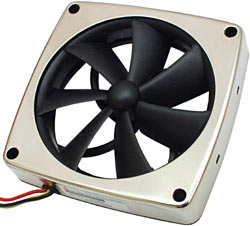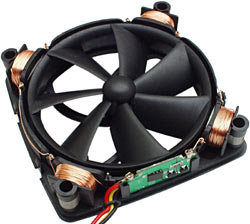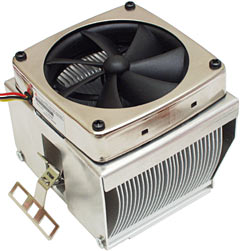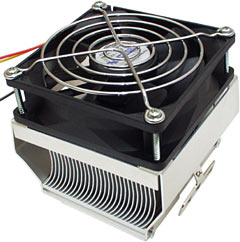
Y.S. Tech TMD fan
Review date: 7 May 2002. Last modified 03-Dec-2011.
Yen Sun Technology Corporation, commonly known as Y.S. Tech, make computer fans. They make a lot of computer fans. And all of their products, up until now, have been pretty similar to the products from other computer fan manufacturers.
Different fan manufacturers make fans with somewhat different blade profiles and somewhat different motor designs and various other points of differentiation, but all normal computer fans are similar in their basic architecture. Frame, impeller, ball or sleeve bearings, brushless motor in the middle of the impeller.
Well, here's something a little different.
Y.S. Tech's new Tip-Magnetic Driving Fan moves the motor out of the hub of the fan, and puts it around the edge. The impeller blades are surrounded by a ring studded with 12 magnets, which are acted upon by four coils that're located at the corners of the fan's frame.
Here's the TMD fan with its lid removed. You can see the four coils, and the little circuit board that controls them.
In essence, this motor design is the same as that of any other brushless fan. Stationary coils, rotating magnets, Hall effect sensors that let the controller know how the rotor's oriented, so it can energise the coils at the right time.
But instead of bunching the whole assembly up inside the fan hub, with the coils sitting on top of the controller board and the magnets surrounding them, everything's been spaced out.
Y.S. Tech have a "technical issues" page for the TMD fans, which explains that this design yields simpler coil windings, more efficient magnetic field structure, assembly as a simple gomphosis (your Vocabulary Word Of The Day), and lower acoustic noise, thanks to the ring-surrounded blades.
On their Application Example page, Y.S Tech further explain that the smaller hub creates less of a "wind shadow" in the middle of the fan. On a CPU cooler, that's where you want more air flow, because the middle of the fan's probably right over the contact point where the heat enters the heat sink.
Which is all very well. The question is whether these fans actually work any better than the ordinary sort.
And the answer, right now, for many people, is no. You don't even have to test the things to know that. Because the first models of TMD fan are 70mm units - bigger than the 60mm fans used on most CPU coolers, but smaller than the 80mm ones used for most case-cooling purposes.
70mm fans are just right for various P4 coolers, and for the few 70mm-square coolers for Socket A and Socket 370 processors. But most people won't be interested until Y.S. Tech release 60mm and 80mm TMD fans, which are promised in the near future.
Bitspower, however, sent me a Socket A/370 CPU cooler with a 70mm TMD fan on it. And, conveniently, two other coolers that use the exact same heat sink as the TMD-fan one, but have normal 80mm fans on them instead.
The TMD-fan cooler is the NP81DT58, which isn't commonly available yet, but can be purchased directly from Bitspower for $US45 (or 50 Euros), for which price you also get one of their new BP478R adapters, which lets you use a Socket A/370 cooler on a Socket 478 Pentium 4.
According to Bitspower, this price includes Fedex shipping "everywhere". Mawson Station residents are probably excepted, though.
The NP81DT58 uses the "middle speed" 5800RPM PD1270155B-2F TMD fan; this fan's the fastest TMD that exists so far. The other options are "low speed" and "extra low speed", model numbers PD1270153B-2F and PD1270152B-2F, respectively. The low speed TMD will be used on Bitspower's upcoming NP81DT45.
The other two Bitspower coolers look identical to each other, and they both use the same 80-by-60mm NP81 heat sink as the TMD-fan unit. These ones have a different frame on top, though, to suit an 80mm fan. They're the "Silence" NP81DS30 and the "Super Silent" NP81DS20, with 3000 and 2000RPM fans respectively.
How do these fans compare with the TMD?
Well, there's an Acrobat-format datasheet for the PD1270155B-2F TMD fan, which you can download from the TMD fan page here. If you don't have the current Chinese Traditional font pack for Acrobat, you'll need it to read all but the last couple of pages of the spec sheet; download it from here.
The flow-versus-pressure graph at the end of the TMD datasheet shows a pretty smooth line from a maximum flow rate of almost 37 cubic feet per minute (CFM) at near-zero static pressure (this is the "free air" result), to a maximum static pressure of 0.2265 inches of water (inH2O) at zero flow (this is the "sealed box" result). In metric, that's 1.04 cubic metres per minute and 5.755 millimetres of water, respectively.
The smoothness of the graph tells you that there's nothing peculiar going on; this isn't some odd fan design that gets tons of air flow in an unrealistic free air test, but can't do much in a real-world situation where there's some flow resistance to deal with.
For a 5800RPM fan, by the way, this one is pleasingly quiet. The spec sheet quotes a noise level of 39.6dB (A weighting) at one metre, and that was with the fan running at more than 5900RPM. There are plenty of 60mm fans around the 5500 to 6000RPM mark that're significantly louder than this; they're all taller units than the TMD fan, but the TMD does better than most of them for air flow, in the free air figures, anyway. Taller fans can generate more pressure, all things being equal, so the TMD is probably broadly even with these louder 60mm units, if you ignore near-field turbulence.
I don't have good numbers for the fans on the other two Bitspower coolers (and, in any case, the manufacturers promise on the pages for the coolers that "The Specification of Fan will be changed without notice"...), but Bitspower rate them at 47.8CFM for the 3000RPM one, and 30CFM for the 2000RPM one. Those are free air ratings of dubious veracity, but unless the numbers are very inflated, they still mean that the NP81DS30 should outperform the TMD-fan cooler, if the TMD fan's different air flow dynamics don't help it.
So I tested all three coolers, on the same rig I use for my big CPU cooler comparison here.
The DS20 managed 0.73°C/W. A perfectly all right result from a nice quiet cooler. The DS30 scored 0.66°C/W; again, about what I'd expect. And the DT58, with the TMD fan obviously shifting more air over the heat sink than the DS30's fan could manage (and obviously making more noise, too), clocked 0.62°C/W.
Which isn't particularly thrilling, but it's less than 20% behind the results of the very best Socket A/370 coolers I've tested. This is all you can expect from a large all-aluminium heat sink without a stupid deafening fan on it; the NP81's got fancy skived fins, but diminishing returns cut in ferociously as you make aluminium heat sinks bigger, no matter how spiffy the fins are.
So there would definitely appear to be something to Y.S. Tech's claims about the TMD fan. The thing isn't an incredible revolution in air-shifting technology, but it does work well; compared with the average low-profile 70mm fan, the TMD's a monster, without being horribly loud.
Performance isn't everything, of course. Price is an issue. And so's coolness. TMD fans look likely to be winners in these areas, too.
How much?
Y.S. Tech have a where-to-buy-TMD-fans page here which, in the great tradition of where-to-buys from Taiwanese companies, leads to various sites that don't list prices, have buy-it-here links that don't work, or don't list the product in question at all.
One of 'em worked, though. It would appear that European buyers will be able to get themselves a TMD fan for 15.50 Euros (about $US14.20, as I write this) plus another 5 Euros for shipping, from Elektrosil Systems' tmdfan.com site. That site says the fans will be available from the 15th of May.
That's a good price. It's less than you'll pay for the super-high-power fans that many overclockers stick on their CPU coolers.
The medium power TMD doesn't have the same air moving ability as an above-six-watt screamer of conventional design, but its more effective airflow seems likely to help, as should the new TMD models on the way.
Atomic batteries to power
And then there's the coolness issue. Will TMD fans impress your fellow computer-tweakers?
Yes. Yes they will.
The TMD fan's impeller and motor, together, make it pleasingly weird for people who're used to normal computer fans.
The impeller looks nifty, of course, but its design also means it's considerably heavier than usual, and also has a high moment of inertia. Most of its mass is around the edge, a long way from the pivot point. Normal fans have their heavy magnets in the middle; this one has them around the rim.
What this means is that the TMD fan takes an impressively long time to spin up to full speed. More than nine seconds, in fact. Most computer fans this size spin up in around three seconds.
The TMD fan also sounds interesting when it's spinning up. The motor controller creates a distinctive electronic squeal on startup, which settles down to a relatively quiet whine that's swamped by the noise of the blades as the fan gets to speed.
I've made a 387 kilobyte MP3 of the TMD fan spinning up and then being turned off; you can download it here. The mike's quite close to the fan for this recording, which means it sounds rather more like a jet car than it does in real life, at least if you don't have your ear close enough to the fan that it's trying to eat your hair. But it conveys the general impression.
I can only imagine that the 80mm TMDs will take even longer to spin up, and sound even more entertaining when doing it. Which'll make them excellent candidates for anybody who's been looking for the perfect 16 fans from which to assemble a whole side panel for his or her computer case.
The heavy rim, by the way, also makes the TMD fan highly gyroscopic. When it's running, it doesn't want to change orientation. All fast fans are somewhat gyroscopic, but this one's quite powerfully so. For computer applications this isn't likely to make any difference to anything, but it's quite fun if you're just playing with the bare fan.
The TMD fan's stall behaviour is peculiar, too.
Normal brushless-motor computer fans don't die if you stop them from turning while they're powered. They just sit there, drawing maybe three or four times more current than usual. Brush motors draw more power and deliver more torque the slower they're turning, and can quite rapidly cause physical or electrical havoc if they're jammed solid, but brushless motors are smarter about it.
The TMD fan's smarter still. If you stall it - by sticking your finger in it as you power it up, for instance - it tries to drive for a moment at quite low torque. Your finger's in no danger at all. Then it goes silent, for two to six seconds, according to the spec sheet. It draws no current while it's silent. Then it tries its motor again, and goes quiet again if it fails to turn. The TMD fan I played with pulsed steadily, once every 1.4 seconds or so.
This means that a jammed TMD fan definitely won't overheat. Whatever it's meant to be cooling might be toast, of course, but the fan at least is in no danger, and the rhythmic squeak as it tries to spin may attract your attention before any damage is done. Regular fans are silent when they're stalled.
The TMD fan, by the way, has a normal three-wire connection, so you can hook it up to a motherboard fan header and monitor its speed in the usual way, if your motherboard supports that. Most do, these days. Fan speed monitoring lets you run software that'll sound an alarm or shut down if a fan stops turning, which is better than some other systems for dealing with dud fans.
Stupid Engineering Tricks
While I was playing with the TMD fan, it struck me that for really optimal performance, a computer fan's blades need to not only be driven from the rim, but also supported there. The TMD fan gets rid of the bulky motor assembly in the middle, but the fan's spindle and bearings are still central. And so there still has to be a little boss in the middle of the fan and, more importantly, supporting arms coming in from the frame. The arms and the spindle base need to be reasonably thick, to give them some strength in case something whacks the impeller. The TMD fan's three spiral arms are thinner than usual - partly because none of them need to provide a wire-route channel - but they're still right next to the blades, and must therefore still cause considerable flow disturbances.
If the impeller were supported by a bearing around its edge - if the whole impeller were built as an extension of the inner ring of some kind of ball or roller bearing - then there'd be no need for the spider of support arms and the central bearing assembly. Thought I.
It then struck me that, unfortunately, this ain't likely to happen. Not at a reasonable price, anyway. Because stuff would have to move too fast.
The centre support bearing of the 5800RPM TMD fan has to spin at 5800RPM. Duh.
The fan's impeller ring, however, has a diameter of about 70mm (the whole fan's a bit big for a "70mm" unit). So its circumference is about 220mm, and it spins 5800-odd times a minute, or about 97 times per second. So the perimeter's moving at about 21.3 metres per second - around 77 kilometres per hour.
The inner ring of the two centre ball bearings is less than 5mm in diameter; it's unlikely to be moving faster than about 1.5 metres per second. Maybe 5.4 kilometres per hour, tops.
Now, the inner bearings are teeny, but unless the balls in them are really amazingly small, they won't be taking a great deal of punishment.
Replace the little bearings with a big outer ring and even if it used big beefy balls, they'd still be ripping around the bearing at a hilarious rate of knots. If you tried to avoid making a large precision bearing by putting a rail arrangement around the edge of the fan and supporting it with three or four smaller bearings (which would leave gaps between the supports for the drive coils, which would otherwise have some trouble getting at the rim magnets), then the little edge bearings would be spinning even faster. A 10mm bearing in contact with the edge would have to spin at more than 40,000RPM.
Centre bearings are, therefore, here to stay. Well, unless and until someone comes up with an air-pressure or magnetic or similar clever-clogs non-contact bearing design that'll work in a moulded plastic fan that sells for less than the price of a Rolex.
Overall
The current TMD fans are genuinely superior to similarly specified conventional fans. But they're the wrong size for most applications. I'll be interested to see the 60 and 80mm ones when they come along.
If you simply must have the weird spool-up sound of a TMD fan in your life right now, then I suppose you're going to have to buy one or more 70mm units as soon as you can.
If you're a bit less nuts, though, hang around for the 80mm ones for case cooling purposes, and the 60mm ones for most CPU coolers.
NP81-series CPU coolers kindly provided by Bitspower.





